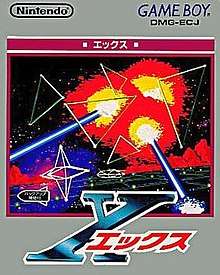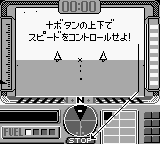X (1992 video game)
X[lower-alpha 1] is a 1992 space combat simulator video game developed by Argonaut Games and published by Nintendo for the Game Boy in Japan. The player assumes the role of the VIXIV starship as it must protect the planet Tetamus II from a mysterious race of aliens. Gameplay involves completing missions assigned by the "Training Academy Coach", ranging from protecting bases from enemy fire or delivering cargo to a certain area.
| X | |
|---|---|
 | |
| Developer(s) | Argonaut Games Nintendo R&D1 |
| Publisher(s) | Nintendo |
| Director(s) | Yoshio Sakamoto |
| Producer(s) | Gunpei Yokoi |
| Designer(s) | Dylan Cuthbert |
| Composer(s) | Kazumi Totaka |
| Series | X |
| Platform(s) | Game Boy |
| Release |
|
| Genre(s) | Space combat simulator |
| Mode(s) | Single-player |
Notable for being one of the few attempts at a 3D video game on the Game Boy alongside Faceball 2000, X was the creation of Dylan Cuthbert, who would later design the original Star Fox for the Super NES. Commissioned by Argonaut president Jez San after being impressed by the Game Boy at the 1991 Consumer Electronics Show, Cuthbert and a team of others were forced to reverse-engineer the system due to official development kits being hard to find. It was designed after Argonaut's earlier game Starglider 2 for the Amiga. Nintendo grew interested in the game during production and convinced Cuthbert and Argonaut to make it a first-party title for the console. A planned North American release named Lunar Chase was cancelled as Nintendo of America felt a game of its type was too advanced for a console meant for children.
X initially received mixed reviews from critics, often being praised for its impressive technological accomplishments but criticized for its high difficulty. Retrospectively, it was acclaimed for its historical importance and gameplay, often being compared to games such as Star Luster. A DSiWare sequel, X-Scape, was released worldwide in 2010.
Gameplay

X is a first-person space combat simulator video game, being one of the few Game Boy games to use 3D visuals. Controlling the starship VIXIV, the player is tasked with completing missions assigned by the Training Academy Coach to protect the planet Tetamus II from being taken over by a mysterious alien race.[1] The VIXIV must complete each of the game's ten stages, referred in-game as "objectives", under a time limit. Objectives range from protecting a base from enemy fire, delivering a load of cargo to a certain area, or shooting down formations of enemies. The VIXIV can fast-travel to other parts of the map by entering large openings found in certain places, with gameplay taking place in a long series of tunnels. Completing objectives awards the player stars, and up to ten can be awarded. A certain number of stars is required to finish each mission, and should the player fail to earn enough will be forced to restart the mission.
The VIXIV has a radar at the bottom of the screen that displays the player's current location and any nearby enemies or objectives. The player can find large openings on the ground in certain areas of the game, which can allow the VIXIV to fast-travel to other sections of the map. The game ends once ten missions are completed.
Development
X was designed by Dylan Cuthbert of Argonaut Games, who would later produce Star Fox for the SNES.[2] After being intrigued by the Game Boy's during the 1991 Consumer Electronics Show, Argonaut president Jez San commissioned Cuthbert to produce a 3D engine for the console and potentially create a game utilizing it.[2] Cuthbert and his development team had to reverse-engineer the Game Boy hardware as official Nintendo development kits were hard to come by, and that Argonaut was virtually unknown to them.[2] A dummy developer kit was produced that had a camera pointing at the system, dismantling the console itself with a Tetris cartridge inserted and connecting it to a board made by another Argonaut employee.[2] Cuthbert began work on X once he became familiar with the hardware, of which he was responsible for adding a portion of the graphics, most of the game design, and all of the programming.[2][3]
The game was created in the style of Argonaut's older computer games, notably Starglider 2, featuring full 360-degree movement through space.[2] Its technological accomplishments quickly caught the eye of a Nintendo employee, urging that they send a ROM of the game to Nintendo's headquarters in Kyoto, Japan.[2] It was presented to both Game Boy creator Gunpei Yokoi and engineer Ishuna, who were "blown away" by its usage of 3D wireframe graphics, requesting that Dylan and his team fly over to Japan and meet them.[2] After being shown to other employees, Nintendo became so impressed with the game that they purchased the rights to it from the original publisher, Mindscape, and made Argonaut an official third-party licensee.[2][3] Assisting developed was Nintendo Research and Development 1 (R&D1), the division responsible for producing the Game Boy itself.[2] The soundtrack was composed by Kazumi Totaka, and is the first game to feature the infamous "Totaka's Song".[4]
At first, the title was named Eclipse, but then-Nintendo President Hiroshi Yamauchi insisted upon it being renamed X, calling up director Yoshio Sakamoto a month before development was completed.[2][3] Nintendo forced Cuthbert and Argonaut to rework the 3D engine entirely due to a game-breaking bug that made it unplayable on certain Game Boy systems, and to appease the company's strict stance on quality.[2] X was released in Japan on May 29, 1992.[5] A North American version titled Lunar Chase was completed by Cuthbert; however, Nintendo of America felt that the idea of a 3D first-person game on a handheld for children was too complicated, and to his disappointment cancelled its release.[2] Cuthbert believed that a lack of interest from retailers was also because of this.[3] In a 2018 interview with USgamer, Cuthbert admitted that he lost the source code for Lunar Chase and didn't think to make a backup copy at the time.[2]
Reception
| Reception | ||||||||
|---|---|---|---|---|---|---|---|---|
| ||||||||
Early reviews for X were mixed, with many praising its technological accomplishments on the system but criticizing its high difficulty. Famitsu magazine compared the game to Star Luster, being impressed by the game's 3D wireframe technology and sense of realism, while criticizing its difficulty for being too hard for beginners especially.[6] Family Computer Magazine had a similar response, saying that it could drive away potential players with its high difficulty level, while simultaneously praising its 3D gameplay and soundtrack, claiming that it could easily be brought over to the Super Famicom with the addition of color and newer features.[7] Nintendo Power staff was impressed by the technical capabilities of the game, comparing the visuals to the virtual reality BattleTech Center in Chicago, calling it one of the most exciting Nintendo titles.[8] Joypad Magazine staff meanwhile found it to be an interesting game, praising it for being so different compared to other Game Boy games.[9]
In retrospect, X has been cited as a landmark title in the Game Boy's lifespan for its usage of 3D wireframe graphics. Polygon listed it as the 30th greatest Game Boy game of all time for being a "tour-de-force of Game Boy technical prowess", highly praising its 3D visuals and free-range movement.[10] They also stated that its technological feats alone made the game worth owning.[10] Writer Sam Machkovech of Ars Technica felt similarly on its technical prowess, calling it "incredible" and lamenting that it was never released in English.[3] Writer Jeremy Parish stated that X was a more impressive creation than Star Fox for not requiring any additional hardware and for being made on the Game Boy, praising its 3D graphics and its more ambitious design compared to Star Fox.[5] Simultaneously, he criticized the game's lack of variety in combat and for several missions being drawn out and repetitive.[5] He concluded his review by saying the game was worth owning for its historical importance and technological accomplishments.[5] He expressed a desire to see it resurrected through a hypothetical Game Boy Mini platform.[11] The book Nostalgia GB Perfect Guide! cited it as an important title in the console's history, saying that it helped pave the way for Argonaut's later game, Star Fox.[12] They recommended the game to fans of similar games such as Star Luster, praising its slow-paced gameplay and soundtrack.[12]
References
- Andrews, Nate (8 September 2011). "Influencing the Fox". Nintendo World Report. Archived from the original on 19 September 2019. Retrieved 20 September 2019.
- Parish, Jeremy (18 September 2018). "A Bathtub Full of Acid: The Story of How Dylan Cuthbert Went From Making 3D Engines for Game Boy to Star Fox". USGamer. Archived from the original on 10 February 2019. Retrieved 19 September 2019.
- Machkovech, Sam (October 3, 2017). "Original Star Fox staffer tells story of sequel's shelving, surprise launch". Ars Technica. Retrieved June 3, 2020.
- Plunkett, Luke (11 August 2011). "The Secret of the Secret Nintendo Song". Kotaku. Archived from the original on 16 February 2019. Retrieved 20 September 2019.
- Parish, Jeremy (5 July 2016). "Game Boy World Gaiden #002: X/Lunar Chase [Argonaut/Nintendo, 1992]". YouTube. Archived from the original on 11 September 2019. Retrieved 19 September 2019.
- "X エックス". Famitsu. Enterbrain. April 1992. Archived from the original on 27 February 2019. Retrieved 19 September 2019.
- "超絶 大技林 '98年春版" (April 15). Intermedia Company. Family Computer Magazine. 15 April 1992. p. 465.
- Japan Watch. Nintendo Power. 1994. p. 112.
- Lunar Chase. Joypad Magazine (in French). 1992.
- Parish, Jeremy (19 April 2019). "The 30 greatest Game Boy games". Polygon. Archived from the original on 19 April 2019. Retrieved 19 September 2019.
- Parish, Jeremy (October 12, 2017). "Rumors swirl about a Game Boy Mini, but what would that actually be?". Retronauts. Retrieved June 3, 2020.
- Nostalgic Game Boy Perfect Guide!. Magazine Box. 25 February 2017. p. 95. ISBN 9784866400259.